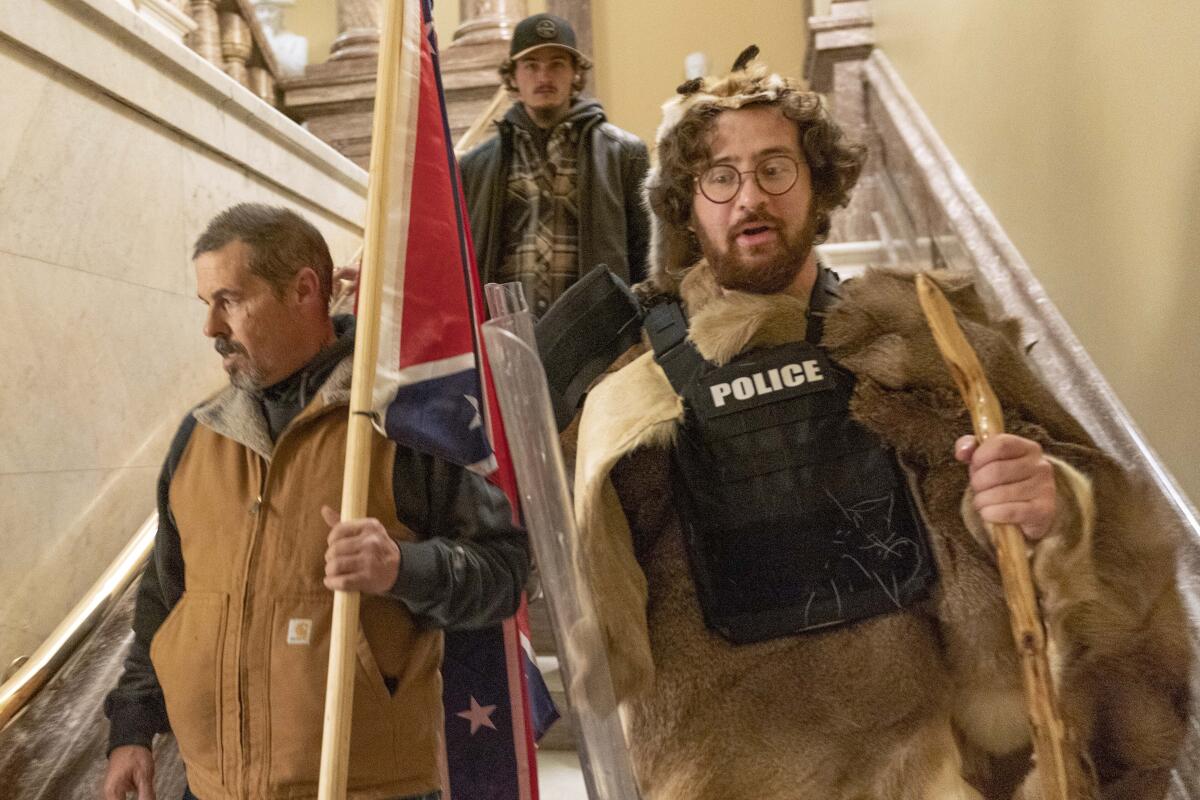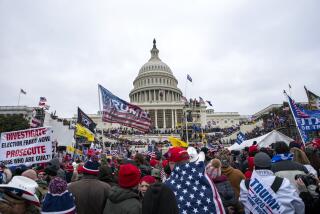Officials eye sedition, conspiracy charges as investigation of Capitol riot expands

- Share via
WASHINGTON — Federal prosecutors have opened a broad investigation of possible sedition and conspiracy in connection with last week’s attack on the U.S. Capitol, officials said Tuesday in their first public briefing on the status of the case.
FBI investigators so far have opened more than 170 individual case files and charged more than 70 people, and “the numbers are going to geometrically increase,” said Michael Sherwin, the acting U.S. attorney in Washington. He likened the effort to the sort of probe that law enforcement officials would conduct after an attack by foreign terrorists.
The number of people charged will probably “grow into the hundreds,” Sherwin said. Although the initial charges against most suspects have been misdemeanors, “this is only the beginning,” intended to identify suspects for further investigation, he said.
“We’re looking at significant felony cases tied to sedition and conspiracy” that could carry prison terms of up to 20 years, he added.
“You will be charged, and you will be found,” he said, in a warning aimed at those who took part in Wednesday’s riot, which grew out of a rally of Trump supporters protesting President-elect Joe Biden’s election.
Until Tuesday’s news conference, officials had released little information to the public about the rapidly expanding investigation — a sharp departure from normal practice in which the Justice Department typically briefs the public frequently on the status of major cases. The Justice Department’s top officials, including acting Atty. Gen. Jeffrey Rosen and FBI Director Christopher Wray, have released written statements but have not made public appearances since the riot.
The news conference comes amid mounting concern about additional violent attacks in the days leading up to Biden’s swearing-in next week. The FBI on Monday warned of possible armed protests against Biden’s inauguration in all 50 state capitals.
House members received a memo Monday evening laying out new procedures, including heightened security for them at airports, where several have been harassed in recent days. The memo also pointedly reminded members that they can use their office funds for certain additional security measures.
“I never thought I’d see a memo that said we could purchase bulletproof vests,” said Rep. Ted Lieu (D-Torrance). “But that’s what it said. That’s what Donald Trump has now caused.”
Rep. Lou Correa (D-Santa Ana) was surrounded at a Washington-area airport the morning after the riot in a confrontation caught on video. Several people shouted and cursed at him, including one man who admitted he didn’t know which member of Congress he was.
“I thought it was a certainty I was going to get physically attacked — a punch or kick or something — but I thought it was something that was going to happen,” Correa said. “We try very hard to be accessible, and I’m going to continue to be accessible — a little more prepared. I always am, but we’ve got to step it up.”
On Tuesday, even members of Congress were required to pass through magnetometers before entering the House chamber.
Sherwin and Steven D’Antuono, the assistant director of the FBI’s Washington field office, defended the bureau’s handling of intelligence before the riot, which included threats of violence. D’Antuono said the intelligence had been passed along to other law enforcement agencies but downplayed its significance.
They also emphasized the scope of the case.
“We have literally thousands of potential witnesses,” Sherwin said, and as more information comes out, the public is “going to be shocked with some of the egregious conduct” that took place during Wednesday’s riot.
The U.S. attorney’s office here, which is heading the nationwide investigation, has assembled a “strike force” of prosecutors to look at sedition charges, Sherwin said, as well as a second group to focus on attacks by rioters against reporters and photographers outside the Capitol.
In addition to interviewing witnesses and scrutinizing more than 100,000 pieces of video, photographs and other evidence submitted by the public, investigators would examine the financial, communications and travel records of those involved to determine what level of planning went into the attack, he said.
The case is “not going to be solved within the coming months,” he said. “Everyone is in for the long haul.”
So far, the two indicated, investigators have not identified suspects in two of the highest-profile incidents in Wednesday’s attack — the killing of Capitol Police officer Brian D. Sicknick and the planting of two pipe bombs outside the headquarters of the Democratic and Republican national committees, both of which are located on Capitol Hill.
The bombs were “real devices” with timers and explosives, Sherwin said, adding that investigators are looking at whether they were planted as part of a “diversionary tactic” to draw police away from the attack on the Capitol.
D’Antuono confirmed a report first published by the Washington Post that the FBI’s Norfolk, Va., office had seen online message traffic the day before the riot in which extremists talked explicitly of committing violent acts at the Capitol.
One message declared that “Congress needs to hear glass breaking, doors being kicked in, and blood from their BLM and Pantifa slave soldiers being spilled. Get violent. Stop calling this a march, or rally, or a protest. Go there ready for war.”
The FBI shared that information with other law enforcement agencies in advance of Wednesday’s events, D’Antuono said, but did not say if the bureau had made an effort to flag the information to senior officials or ensure that the Capitol Police force was aware of the potential threat.
In advance of Wednesday’s rally, the FBI had “developed some intelligence” about specific people who might be planning violent acts, he said. That led to the arrest two days before the rally of Henry “Enrique” Tarrio, a leader of the Proud Boys, an extremist group with a long history of violence.
But investigators need to distinguish between “keyboard bravado” and threats of “real harm,” he added, and in the case of the messages seen by the Norfolk office, the bureau “had no indication” that they were tied to a specific threat.
Congressional leaders have vowed to investigate why the Capitol Police were so unprepared for the attack. The sergeants at arms of both the House and Senate — the two officials who oversee security for the Capitol — as well as the chief of the Capitol Police have all resigned.
Staff Writer Jennifer Haberkorn contributed to this report.
More to Read
Get the L.A. Times Politics newsletter
Deeply reported insights into legislation, politics and policy from Sacramento, Washington and beyond. In your inbox three times per week.
You may occasionally receive promotional content from the Los Angeles Times.











